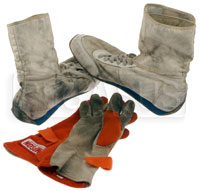By John B. Haydon
At this time of year, it's too cold for many of us even to go into the garage to look at our racecars. If you're in the same climate, take this opportunity to look over your driver's safety gear. Is it really ready for the demands of another season of racing?
Be honest with yourself. You may be able to convince a tech inspector to let it slide "just this once," but you won't have the same luck convincing the flames to stay away from your frayed gloves or worn driver's suit.
If in doubt, get a second opinion from someone who cares about your well-being. It doesn't have to be a racer. Spouses, parents, and bosses who want to see you at work on Monday can all be brutally honest when you're about to put yourself in danger.
Gloves: Despite their cost, gloves should be considered an expendable item. They do wear out and will need to be replaced, probably several times in your racing career. If you have any trouble justifying the expense, compare the cost of a new set of high-quality gloves to the cost of just one new racing tire.
Your gloves work hard, rubbing against the steering wheel at every turn and grinding against the gearshift knob with every shift – not to mention snagging on any loose edges in and around the cockpit. Gloves also absorb lots of acidic, leather-eating perspiration and then get crumpled into a stuffy gear bag at the end of each race.
Examine your gloves for fraying, splitting seams, and cracking leather. Seams can sometimes be sewn with Nomex thread, but bad fraying and cracked leather necessitate replacement. Save your old gloves for emergency spares only if they don't expose any skin.
Helmet: Sure, your helmet has a "new enough" Snell rating and a snazzy custom paint job, but what is the honest condition of your helmet? Will it still be able to protect your head in a hard impact? Has it been left in the sun all day, every weekend? Have you dropped it on the floor a few times? Let's not even discuss that time you threw it on the ground.
And don't forget that the shell is only one part of the helmet. Its primary job is to hold the liner tight against your head. The liner is the part that works hardest to protect your brain from injury in an incident. Just wearing the helmet for several seasons will eventually compress the liner, compromising its fit and its ability to absorb impact.
If you decide to replace your helmet now, your helmet painter should still have time in his schedule for another snazzy paint job before your first race. While you have your helmet out, clean and check the visor. Is it scratched or pockmarked? Do you need a darker or lighter tint? How about installing a fog shield or tear-offs?
Underwear: (You do wear Nomex underwear, don't you? Why not? It can give you about five more seconds to escape from a burning car!) Check for holes, snags, and pulled seams. The weave on Nomex underwear can be pretty fragile, and the holes always seem to develop in the crotch area first. Not only is this embarrassing, but even minor burns in this region can be dangerous. If you can repair the hole, consider replacing them anyway. Again, you can save the old set for emergency spares if no skin is exposed.
Shoes: Shoes in need of replacement are usually pretty easy to spot. Soles can separate from the uppers and expose the toes, or holes can develop in the sole at the ball of the foot. Besides offering less protection in a fire, these holes invite disaster by snagging on the edges of the pedals. And don't think a few layers of racer's tape wrapped around the shoe is a good repair. When your foot gets glued to the throttle because the tape has shifted and exposed the adhesive... well, let's just say I had to learn fiberglassing the year I tried that trick.
Pay attention to the laces, too. Replace frayed laces now, because they'll never break when you untie them at the end of the day -- they'll break just after your group gets the last call to the grid. If your shoes pass the visual tests, put them on and walk across the room in them. Pay attention to the soles. Some rubber compounds break down with age, allowing the soles to disintegrate from the inside. The resulting feeling is odd at best, and an accident waiting to happen at worst.
Suit: Suit problems are also generally pretty obvious. Look for tears, ripped seams, broken zippers, and worn Velcro. If you celebrate the holidays the same way many Americans do, now is the time to try on your suit so you'll have a chance to start dieting and exercising in order to fit into the same suit this spring. If that just isn't going to happen this year, place your order for a custom suit NOW. Don't wait until two weeks before your first event and expect a major suit manufacturer to rush your suit past all of their NASCAR, CART, IMSA, and F1 orders.
Miscellaneous: How is your supply of tear-off shields? Even if you don't need them on the track, they can protect your shield if you install one on your (clean) shield before putting your helmet in your bag. How about fresh earplugs? (You don't wear earplugs? I know, YOUR car isn't that loud, but what about the guy you're following? Remember that time #66 lost his muffler, and you passed him going under the bridge? Can you hear me now...?)
Or maybe you need to invest in a head and neck restraint device. Most racing organizations require one now, so if you think yours doesn't... double-check to be sure you didn't miss a rule change! Trying on a new device and installing helmet anchors takes time. This is another situation where waiting too long could cause you to miss the first event.
If you follow these suggestions, your safety gear should be ready for the upcoming season. Later we'll discuss what areas on your car need similar off-season attention, but that's an article for a warmer day.
Published January 29, 2004 – and the wind chill is -25°F.


